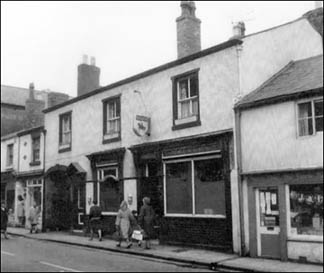
Brook Place: The Liverpool Arms stood at the junction of Lyon Street, Wellington Street and Brook Place, Newtown. It is shown on a map of 1870 but, for the moment, we know nothing more about it.
Brook Street: The Queen's Arms (nos 21 & 23: illustrated below) Licencee in 1850-57 Samuel Higginson, in 1871 Charles Higginson, in 1880 Jas. Higginson, in 1898 Alex. L McLaren, in 1902 Mrs Francis Chetham, in 1910 Oliver Ormrod, in 1914-20 Charles Price, in 1934-42 John Frederick Hill. The Qeen's was demolished when this end of Brook Street vanished under the course of the Inner Ring Road.
In July 2009, Mrs Sian Woosnam wrote to ask for our assistance, "Hi, I am researching my family tree and have discovered that my Great Grandfather, John Frederick Hill, ran the Queen's Arms pub in Brook Street. I am hoping to get a photo of this pub and wondered if you could help me?"
We're happy to oblige and a larger version of this photograph has been sent to her and is now in our gallery.
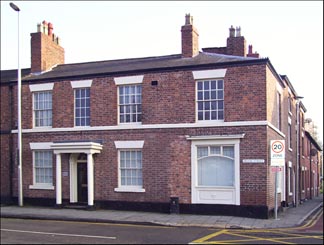 The Glynne Arms (no.100, corner of Francis Street, illustrated right in February 2010). Landlord in 1857 E Pilsworth, in 1880 George West, in 1902 John Clarke, in 1910 Frederick William Attewell, in 1914 James Lowe, in 1919-20 J Anslow, in 1934-6 Harold Kelsey, in 1942 Harold E Miller. The Glynne Arms (no.100, corner of Francis Street, illustrated right in February 2010). Landlord in 1857 E Pilsworth, in 1880 George West, in 1902 John Clarke, in 1910 Frederick William Attewell, in 1914 James Lowe, in 1919-20 J Anslow, in 1934-6 Harold Kelsey, in 1942 Harold E Miller.
In January 2006, reader Dave Huxtable contacted us about the old Glynne, "We understand that the building was used as an antiques shop until
around 1973 when it was sold to Powell Insurance Brokers who used it
for their offices until we bought it late last year again for use as
our office. We are Consulting Civil and Structural Engineers and deal
with a lot of Chester's old buildings. The cellar still survives, with
the 'beer drop', though well boarded up to prevent access, and some
storage facilities. Upstairs, on the ground and first floors no trace
remains however as it is very much converted into offices. There is a
very fine porch which looks as if it is original. We have an old
(1973-ish) photo of the Francis Street elevation and the front corner
return to Brook Street. We are keen to see an old photo so we can
'restore' the front, and want to put in sympathetic windows, and in
particular the porch back to an original likeness".
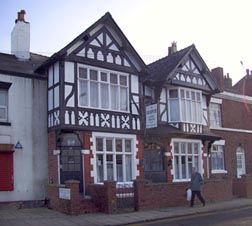 If anyone can come
up with a picture of the old Glynne, contact Dave directly (and we'd like a copy for this site too!) You can see a larger photograph of the place- and and also a fine one of its bar and licencee from the 1950s- in our gallery. If anyone can come
up with a picture of the old Glynne, contact Dave directly (and we'd like a copy for this site too!) You can see a larger photograph of the place- and and also a fine one of its bar and licencee from the 1950s- in our gallery.
The Ormonde Arms Hotel (no 126, illustrated left in February 2010). Landlord in 1898: Thomas Bayley, in 1902 the refined-sounding Saville Nice, in 1910 to at least 1920 James Darling, in 1934-6 William Delmage.
It closed as a pub in, we think, the 1950s but remains with us as a handsome building today, trading as The Ormonde Guest House.
It was originally named after the Duke of Westminster's favourite racehorse. You can see a larger photograph of it, and also one showing it when it was a pub, in our gallery.
The Bridge Inn appeared in the 1859 Post Office Directory of Cheshire, licencee William Oxton.
The Bowling Green Inn (nos 24 & 26, now The Catholic Social
Club).
Its landlord in 1822-28 was Samuel Whittingham- the inn then being described as being in 'Flooker's Brook'. In 1850-59 Hugh Maddock was in charge, in 1871-1880 Wilkinson Booth, in 1898 John Lake, in 1902-1910Mrs Sarah Jane Chapman. She left in 1911 and a couple of years later, the ancient inn was demolished and rebuilt as we see it today. A plaque above the door declares 'rebuilt 1914' but there is some evidence that this occurred a year or so earlier.
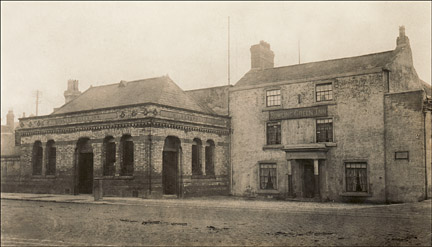 In 1914 the licencee was Mr G Taylor, in 1919-20 A F Griffiths, in 1934-42 Frank Joseph Calderbank. Tony Vye was a licencee during the 1960s. In 1914 the licencee was Mr G Taylor, in 1919-20 A F Griffiths, in 1934-42 Frank Joseph Calderbank. Tony Vye was a licencee during the 1960s.
The inn was listed as 'Ye Old Bowling Green Hotel' in 1936. It is now home to the Catholic Social Club.
The bowling green behind the inn is one of the
oldest in Britain- having been in use since the 16th century- but, in
2001 was threatened when the Catholic Church sold the land for
the erection of a huge development of
'retirement apartments'- some of the newly-installed residents of which had the
brass neck to promptly complain about the music coming from the social
club!
The green was for a while rendered useless as anything other than a mere decorative lawn, but, in December 2008, we received the following cheering communication from the club's manager, Mr John Kenyon,
"A great site- just to update you on the 'decorative lawn'/ bowling green. We have now been bowling on the green since May 2008 and it is in very good shape in view of the years of neglect before it was handed back to us. In fact, with another 12 months under it's belt, there will not be many in better shape in this area. Although we do not have a team in the local leagues, the green has been well used by the regular members of the club and I have to say it is as much a 'pub game' now than I can recall for many of the 23 years I have worked here. As well as our members, we have had visiting clubs from Frodsham and Huyton who have enjoyed their time with us immensely. Both teams will be paying repeat visits in 2009. Early days yet, but the green is in good health!!
The reason why the green was so long in being returned to a playable condition was due to the legal wrangles that arose when the developers and the building firm went bust. It was handed back to us in an awful state but eventually (after a lot of hard work- I had the blisters to prove it!) we got it to a position where Bob, our green keeper, could start work in earnest.
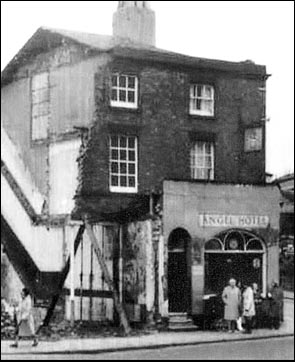 Thanks for the quip about the neighbours' complaints. That was a while back and we hear nothing from them anymore (fingers crossed). In fact, some of the residents are now members of the club and play bowls too! Cheers, John!" Thanks for the quip about the neighbours' complaints. That was a while back and we hear nothing from them anymore (fingers crossed). In fact, some of the residents are now members of the club and play bowls too! Cheers, John!"
Thanks to you John. We'll be giving the old Bowling Green a page of its own soon..
The Angel Hotel (no 96, corner of Egerton Street. Phillipson & Golder say no 1 Egerton Street, illustrated left) Its site is now occupied by the Chester
Lodge Residential Home. The Angel is remembered by
some oldies for 'the clock in the window'.
Landlord in 1871 Joseph Bromley, in 1880 Thomas Millington, in 1898: George Gregg, in 1902 Leonard Pearson- who was still there in 1914, in 1934-5 Mrs Owen, in 1936-42 Horace Owen. Harold & Muriel Jones had the place in the late 1960s before moving to the nearby Railway Inn (see below) in June 1972. Their son Douglas looked after the Angel during its final six months, his father Harold holding both licences during this time.
A couple of photographs of the place, and the nursing home that replaced it, may be seen in our gallery.
Talking of which, in 2004,
time was called on The Liver Hotel (110 Brook Street, illustrated below in February 2010) We heard that the
hotel next door planned to extend into it but, a couple of years later,
January 2006, nothing has been done and the place sadly remained closed. In October 2006 the pub's front was suddenly covered in scaffolding and, by Spring 2007, the place was looking better than it had in years, having been superbly restored and relaunched as the Lloyd's of Chester Hotel.
In 1910-14 the licencee was Edward Embrey, in 1919-20 Mrs G Whitley, in 1934-5 Mrs A Kimpton, in 1936 Mrs Evelyn Esther de Gregory, in 1942 W Humphries.
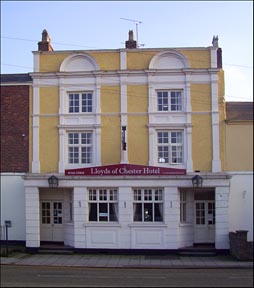 Much earlier, in the opening pages of his Stranger's Guide to Chester (1856) Thomas Hughes, adressing visitors arriving via the new-fangled railway, wrote of the Liver, "those
carpet bags and cloaks, by the way, are but superfluous companions for
a jaunt around the city. Suppose then, that we drop in at the Liver, a
most respectable hotel within hail of the station, and there depositing
our baggage in one of the cosy bedrooms of that establishment, we will
sally forth upon our mission. After one night's sojourn at this house
you'll know your hotel, we promise you, for all future time". Much earlier, in the opening pages of his Stranger's Guide to Chester (1856) Thomas Hughes, adressing visitors arriving via the new-fangled railway, wrote of the Liver, "those
carpet bags and cloaks, by the way, are but superfluous companions for
a jaunt around the city. Suppose then, that we drop in at the Liver, a
most respectable hotel within hail of the station, and there depositing
our baggage in one of the cosy bedrooms of that establishment, we will
sally forth upon our mission. After one night's sojourn at this house
you'll know your hotel, we promise you, for all future time".
It is said that, in former times, beer was brewed on the premises, the water for which was drawn directly from a culverted stream, the Flookersbrook, that flowed- and doubtless continues to flow- beneath the building and from which Brook Street derives its name. You can see a larger photograph of the Liver in our gallery.
Chester's only surviving
cocoa house signs- and very fine ones they are- are beautifully preserved on the facade of what was once Zorba's Greek restaurant then Donato & Sandro's Italian restaurant, the former Railway Cocoa Rooms, built in 1880 and standing between Hoole Bridge and the old Glynne Arms.
Originally the brainchild of the Society of Friends- the Quakers- and supported by the church and the Grosvenor family, cocoa houses came about due to pious concern that Chester's working men were preferring to spend their time and money in warm and cosy pubs and 'gin palaces' rather than staying in with their families in their cold, damp homes- or even going to church. Interestingly, prominent among those reforming Quakers were the Cadbury and Fry families- chocolate manufacturers. Could it be that their concern was as much about profits as moral improvement?
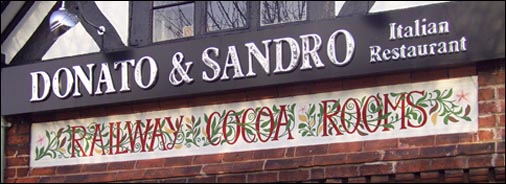 The Chester Cocoa House Company Ltd acquired a number of premises over time. These included The Little Nag's Head in Foregate Street, the still thriving, Falcon Inn, a splendid 17th century building in Lower Bridge Street, which became as a Grosvenor-sponsored cocoa house in the same year as the Little Nag's Head, 1878. There was also a business known as The Market Stall in Northgate Street and The Railway Cocoa Rooms here in Brook Street. This was the only one purpose-built as a temperance house. The Chester Cocoa House Company Ltd acquired a number of premises over time. These included The Little Nag's Head in Foregate Street, the still thriving, Falcon Inn, a splendid 17th century building in Lower Bridge Street, which became as a Grosvenor-sponsored cocoa house in the same year as the Little Nag's Head, 1878. There was also a business known as The Market Stall in Northgate Street and The Railway Cocoa Rooms here in Brook Street. This was the only one purpose-built as a temperance house.
The movement, almost inevitably, proved to be something of a failure. Quite how long the cocoa craze lasted locally is unsure, but by twenty years layer, 1898, the Little Nag's Head had reverted back to the sale of stronger drink..
In early Summer 2011 this attractive and historic building was reopened by Beer Republic as a bar / restaurant by the name of Kash and then, in Spring 2017, it changed hands yet again, transforming into The Deva Tap, the first pub acquired by the Sandycroft-based Deva Craft Brewery. A year later, and the brewery was no more but the Deva goes from strength to strength. It is this writer's local and beers may be bought for him here on most evenings :)
You can learn more about these teetotal establishments when we visit the first of them to be established in Chester, The Old Nag's Head in Foregate Street, and also in our brief feature about them here.

The Rose & Crown. Listed in Pigot's Directory for 1828-1829 when the licencee was William Grice. Another Rose & Crown was trading in Bridge Street in 1809.
The Railway House. Listed in the History, Gazetteer & Directory of Cheshire, 1850 when the licencee was Ann Farmer. This also mentions The Railway Inn in Brook Street, which closed only recently. Slater's Directory for 1855 records The Railway Inn and The Railway House, licencee William Oxton. By 1871, the latter had changed to The Railway Vaults, licencee R Smith.
The Railway Inn at the top of Brook Street, opposite the still-trading Egerton Arms, closed in 2014 and became the premises of a funeral director's- Funerals From The Heart. That's a first! Their website contains some views of the interior as it is now that may be of interest to past habituees. Historic material about this house to follow. The licencee in 1919-20 was E Bennett, in 1936 Cecil Frederick Ford, in 1979-81 Harold & Muriel Jones. They were at the Angel (see above) before this. Robert Evans had it for about 12-13 years and left around 2002-2003.
The Railway Inn will be getting its own page in our 'lost pubs gallery' very soon..
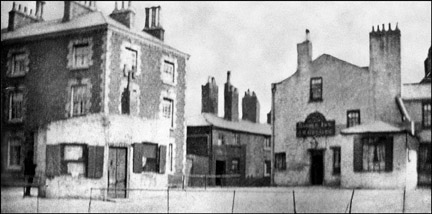 The Liverpool Arms. Listed in the History, Gazetteer & Directory of Cheshire, 1850 when the licencee was Robert Drury, in Slater's Directory 1855 licencee Lydia Drury and the Post Office Directory of Cheshire in 1857, when it was called The Liverpool Arms Commercial Inn, licencee Thomas Hobday Jnr. In 1871 Sarah Handley had the place. There was a Liverpool Tavern trading in Tower Street and The Liverpool Arms ('The LA'), but bearer of many previous names, continues to thrive close to the Northgate. The Liverpool Arms. Listed in the History, Gazetteer & Directory of Cheshire, 1850 when the licencee was Robert Drury, in Slater's Directory 1855 licencee Lydia Drury and the Post Office Directory of Cheshire in 1857, when it was called The Liverpool Arms Commercial Inn, licencee Thomas Hobday Jnr. In 1871 Sarah Handley had the place. There was a Liverpool Tavern trading in Tower Street and The Liverpool Arms ('The LA'), but bearer of many previous names, continues to thrive close to the Northgate.
Bunce Street: (off Grosvenor Street, leading to St. Mary's Hill): The Saddle Inn was formerly located in Bunce Street, as seen in the photograph on the right. Soon after this was taken, the inn was entirely rebuilt on the nearby vacant site in Grosvenor Street seen in the foreground where it continues to trade today, albeit as 'The Chester Bells'.
The Labour-in-Vain appears in the 1818-20 edition of Pigot's Directory, the location is given as "Bun's Lane" and the licencee John Williams. In 1822 it was E Rowland.
The Horse & Groom. Listed in Pigot's Directory for 1828/9 when the licencee was Joseph Moss. Also in Slater's Directory of N & S Wales etc., 1880 (actually listed under 'Bunt Street' but we think this was a typographical error- or do you know better?)
Regular contributor Jeff is of the opinion that all of the three above may have in fact been the same place; The Chester Bells may have been called The Labour in Vain and The Horse & Groom before that because the Horse & Groom ended just as the Saddle Inn started. And how many pubs were there likely to be on such a tiny street?
"A productive drunk is the bane of moralists." Anonymous, 18th century
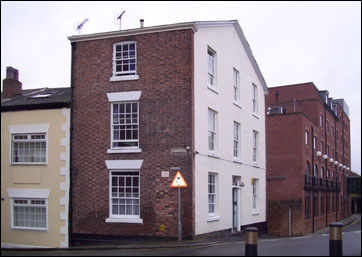 Canalside: The Grosvenor
Arms- situated on the corner of Queen Street, now private rented premises. Reader John Owen wrote to tell us, "my great great grandfather John Pritchard was the landlord in the 1871 census and he was still the landlord when he died there in 1879. I would love to hear from anyone who had further information about this pub". Email John. Canalside: The Grosvenor
Arms- situated on the corner of Queen Street, now private rented premises. Reader John Owen wrote to tell us, "my great great grandfather John Pritchard was the landlord in the 1871 census and he was still the landlord when he died there in 1879. I would love to hear from anyone who had further information about this pub". Email John.
Sarah Morgan was licencee in 1840, when the house was called The Grosvenor's Arms Tavern, John Perry
in 1850, Joseph Wilson in 1902. Kelly's Directory at this time listed the pub as "The Grosvenor Tavern", as did the Post Office Directory of Cheshire in 1857 when the licencee was J Perry. Curiously, Slater's Directory for 1880 still lists John Pritchard as licencee even though, according to John's letter, he'd apparently passed on the previous year.
The Crown Vaults- no. 33, corner of Seller Street, opposite what is now the Mill Hotel.
Illustrated right in February 2010. Landlord 1895-c1901 John Probert (read more about him on the Seller
Street entry). In 1910 Thomas Gilbert Davies.
The Grosvenor Arms and The Crown Vaults were both founded in the 18th century to cater to the
boatmen on the canal and the workers in the chemical works, sawmills,
corn mills and other industrial establishments that once proliferated
in this area. Find out more here.
Another Crown Vaults was trading at 22 Lower Bridge Street in 1890. We've also found another one whose location is currently a mystery. Can you help?
Canal Street (formerly Dee Lane): The Canal Tavern. Listed in the History, Gazetteer & Directory of Cheshire, 1850 when the licencee was James Knight.
The Home Guard Club at the bottom of Canal Street was demolished in July 2014 after falling into disrepair. Founded in 1945, the club's original home was in Lower Bridge Street, later moving to Roodee House and then Watergate House in 1964. It took over its purpose-built Canal Street premises in 1969 and remained there until the deteriorationg state of the building necessitated its sad closure. The cleared site of the old club is owned by the Canal and River Trust. They are utilising it as a car park until another use can be found for it..
The Brown Cow Inn stood on the corner of Upper Northgate Street and Dee Lane, later known as Canal Street. opposite the Blue Coat School and across the street from the still-thriving Bull & Stirrup.
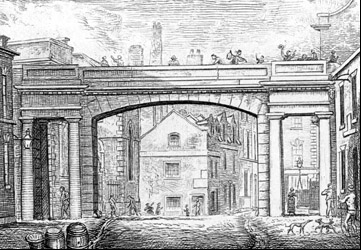 It was known successively as The Chaise and Horses, between 1801 and 1808 as The Coach and Horses, The Brown Cow and The Wheat Sheaf, reverting to the name 'Brown Cow' some time before its sale to Chester Corporation in 1882. It was bought under powers bestowed on the Corporation by the Public Health Act, 1875, in pursuance of a scheme to widen and improve Canal Street and was later demolished when that occured in the 1880s. Its foundations and cellars doubtlessly still exist beneath the roadway. It was known successively as The Chaise and Horses, between 1801 and 1808 as The Coach and Horses, The Brown Cow and The Wheat Sheaf, reverting to the name 'Brown Cow' some time before its sale to Chester Corporation in 1882. It was bought under powers bestowed on the Corporation by the Public Health Act, 1875, in pursuance of a scheme to widen and improve Canal Street and was later demolished when that occured in the 1880s. Its foundations and cellars doubtlessly still exist beneath the roadway.
In 1849-55 the licencee was Thomas Jones (see below), in 1871 Henry Dixon, in 1880 its final landlord was Henry Dodd.
We can see the Brown Cow through the arch of the Northgate in this old drawing- to date, the only illustration of the place we've come across.
Reader Jane Hastings sent us the following report in the Chester Chronicle of 5th October 1849 of a violent attack upon her great great grandparents, Thomas and Ann Jones during their tenure of the Brown Cow..
"Joseph McDonald, Mary Coyle and Elizabeth McDonald were charged with violently assaulting Mr Thomas Jones, landlord of the Brown Cow, Northgate Street, on Friday night. The defendants went into the house very late and asked for liquor, and, as Mrs Jones refused to supply them, she was struck a violent blow by one of the parties. Mr Jones, on going to the assistance of his wife, was attacked in a most violent manner with a poker, and severely beaten around the head. The defendants were fined £3.00 each, and costs for the assault. The fine was paid by Joseph McDonald, and in default of payment, the other two were committed to prison for two months".
Castle
Street: The Robin
Hood
Inn (no 10). Thanks
to
Mr
Roger
Moore
for
this
one.
He
tells
us
his
grandparents,
Mr
and
Mrs
Penn,
ran
the
pub
at
one
time. The licencee in 1855 was Thomas Taylor, in 1857-8 William Musgrave, in 1871-80 Nesbitt Hull, in 1902 Edmund Jones. It was located on the same side of Castle Street as the Golden Eagle (see below) and near to the junction with Lower Bridge Street. It appears on this 1847 Chester OS map.
Prior to 1855, the Robin Hood had borne the curious name of The Split Crow- one of many inns in Castle Street, as we shall see, with an avian connection. It was listed as such in Pigot's Directory for 1828/9 when the licencee was William McConnochie (who was still there in 1840), and in the History, Gazetteer & Directory of Cheshire, 1850. Its licencee at that time was Ralph Gregory. Slater's records the inn in 1855 but gives no licencee.
There was an inn by the name of The Crow in Castle Street in 1809 when it also appeared on the polling station list. Was this the Split Crow?
The Chester Trades Directory notes The Egerton Arms Tavern trading in Castle Street in 1840, licencee Charles Hallows. Another long-established Egerton Arms continues to thrive in Brook Street today.
The Spread Eagle- existing in 1725: it was mentioned in Robert Freke Gould's The Four Old Lodges (1879) as being a masonic lodge meeting place in that year. In 1781 the Chester Trades Directory has it liasted in the plural as 'The Spread Eagles', proprietor Mr Griffith. This inn was listed as The Spread Eagles in Cowdroy's Directory in 1789 when the licencee was still Mrs Griffith. It was recorded as being used as a polling station in 1809. In 1818-20 it appears in Pigot's Directory both as The Eagle Tavern, licencee Robert Oldham (still there in 1823) and The Spread Eagle, licencee George Jepson (still there in 1822-3). By 1828, it was simply The Eagle, landlord William Foulkes. Is this house The Golden Eagle (no 18 Castle Street: see below) of today? The licencee there in 1840 was William Foulkes (who was also listed as a glover in the trades directory for thay year) and in 1910 was Mrs Catherine A Hunter. In 1934 the licencee of The Golden Eagle was Mrs C A Osborne MBE. Can anyone tell us how she earned this honour?
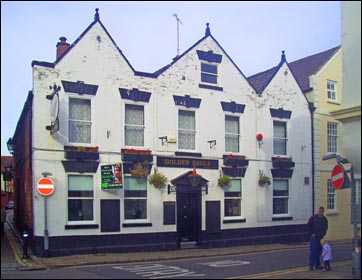 The Golden Eagle ("originally built 1459" according to its former sign) in Castle Street closed in mid- October 2010, when this photograph of the handsome building was taken. The Golden Eagle ("originally built 1459" according to its former sign) in Castle Street closed in mid- October 2010, when this photograph of the handsome building was taken.
The place briefly reopened in May 2011 but that didn't last long. However, towards the end of the year, the place was taken on by veteran 'mine host' Martin Ellis and consequently looks to have a healthy immediate future (and therefore, hopefully, no further place in these pages, but what the hell).
Robert Freke Gould's The Four Old Lodges also lists The Double Eagle in Castle Lane as being a Masonic Lodge meeting house in 1724. Did this become The Spread Eagle- but still a Lodge meeting place- just a year later?
In the 18th century, The Queen's Head was recorded trading in Gloverstone- the Castle end of Castle Street and over the road from the recently-demised Golden Eagle. The licencee at the time was Jane Chatterton.
The Globe. Listed in the History, Gazetteer & Directory of Cheshire, 1850 when the landlord was John Davies, who was still there in 1857. It is also in Pigot's Street Directory for 1828-9.
The Cock / Golden Cock / Cock Tavern (25 Castle Street) was built in 1707 and was trading as an inn by 1822, licencee Lydia Knowles. In 1828 William Owens was in charge. In 1850 (when it was again listed in the directory as The Cock Tavern) the licencee was John Neild. It belonged to Seller’s Brewery of Foregate Street by 1840. The trades directory in that year lists the licencee as Thomas Ainsworth. But in that year they advertised it as to be let (Chester Chronicle, 14 February 1840):
"Public House to be Let. That old established Public House, known by the sign of the COCK, in Castle-street. It may be entered upon on the 3rd of February next. Apply to Seller & Sons, Brewers, Chester".
The building is still with us today, beautifully restored and converted into apartments with offices below, currently occupied by the public services trade union UNISON. Look for the inscription in th cornice high on the front, DOMINUS ILLUMINATIO (the opening words of Psalm 27, 'The Lord is my light'): ANNO DOMINI 1707. It appears on this 1847 Chester OS map (where you can also see a photograph) as The Golden Cock, situated directly opposite the Golden Eagle. Here is its entry in British Listed Buildings.
The Castle Tavern appears in Pigot's Directory in 1818-20, landlord T Wainwright, and in 1822 licencee T Pugh. It seems that it was later taken on by Charles Edwards and renamed The Castle Inn and Owen Glyndwr Tavern. According to an advertisement in the Chester Chronicle, 3 July 1840:
"CASTLE INN AND OWEN GLYNDWR TAVERN, adjoining the Castle Yard, Chester. J. Edwards (Son of the late Mrs. Edwards, of the Holly Bush) begs respectfully to inform the inhabitants of Chester, and especially the farming gents in the neighbourhood, that he has entered upon the above house, and he trusts from the accommodation it is capable of affording, and by observing the strictest assiduity and attention, to merit a share of their patronage and support. Gentlemen attending the Assizes, Races, or on pleasure &c. will find it replete with every comfort, on moderate terms. Wines, Spirits, Ale, and London Brown Stout, of the finest quality. Breakfasts, Dinners, &c. on unusually moderate terms. Good Stabling".
The advertisement was repeated on 10 July 1840, with the name corrected to Chas. Edwards, and again on 14 August 1840 in connection with the Assizes. The whereabouts of the Holly Bush is unknown.
The Castle Inn is listed in the 1857 Post Office Directory of Cheshire (licencee P Williams). It later seems to have been renamed The Castle Inn & Royal Canteen in the 1850s. The Royal Canteen was listed in a Cheshire directory for 1880 when the licencee was William Edwards but was called The Royal Standard from 1888. The licencee in 1902 was David Clements. It appeared in Kelly's Directory in 1910 as The Royal Standard, licencee William H Hughes. Located at 29 Castle Street, it closed in 1912. Another Castle Inn formerly traded in Nicolas Street.
As part of a city police court report, the Cheshire Observer mentioned the inn in June 1873, referring to it as "the Royal Canteen or Cock Inn" and its ownership transferring from William Musgrave to William Edwards.
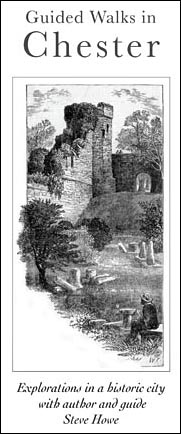 Cowdroy's Directory in 1789 listed an inn called The Granby's Head trading in Castle Street, the licencee being John Hitchins. Cowdroy's Directory in 1789 listed an inn called The Granby's Head trading in Castle Street, the licencee being John Hitchins.
"The function of the pub is company, human nearness... snugness not smugness". Architectural historian and critic Nikolas Pevsner
Christleton: The Glass House Inn. An article by Dave Cummings in a 2003 Christleton parish magazine recalled the funeral of one Robert Townsend in May 1791, and also this inn, as follows:
"The funeral party would almost certainly have proceeded to the Glass House Inn where Mr Witter kept good ale & an eating house. In the diaries of Henry Prescott we learn a great deal about this particular place, first recorded on the John Ogilby map of Britain in 1685. It seems to have been an excellent eating place where the nobility of the city and county would gather, and meals including whitebait, lobster and Sir Loyn of beef were served. The Inn had a fine cellar of wine & beers and offered a good selection for Henry Prescott himself to sample.
Employed as a finance officer for the Chester Diocese, Henry seems to have travelled extensively, and was always trying out the spirits, wines and local beers as part of his unofficial duties. Certainly the number of times in his diaries that he writes “that he has taken one or two early morning circuits around the Roodeye to clear his head”, indictates that he took his drinking seriously.
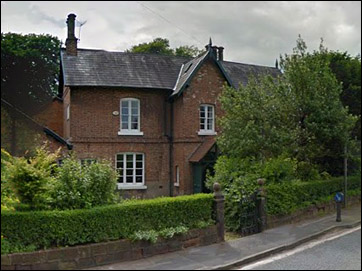 He travelled to Christleton, not only to sample the local brew, and have a small wager on horses, racing at Farndon, or perhaps gambling with his friends at the Glass House Inn, but also to visit his friend Mr Townsend at The Old Hall, often accompanied by his beautiful wife Suzanna. They would sometimes continue their journey on horse back through to Wareton, (Waverton) to see their son Jack who was the Curate there. He didn’t have a very good reputation, as he was often absent when needed, and seems to have been dismissed from his post because of these bad habits. He travelled to Christleton, not only to sample the local brew, and have a small wager on horses, racing at Farndon, or perhaps gambling with his friends at the Glass House Inn, but also to visit his friend Mr Townsend at The Old Hall, often accompanied by his beautiful wife Suzanna. They would sometimes continue their journey on horse back through to Wareton, (Waverton) to see their son Jack who was the Curate there. He didn’t have a very good reputation, as he was often absent when needed, and seems to have been dismissed from his post because of these bad habits.
Left: The Glass House Inn today: a private residence and Grade II listed building
The Glass House was also a meeting place for funerals, being the first Inn outside the City boundary. There are records of distinguished persons, including the Lord Bishop and Mayor & Corporation, coming out of the city to assemble at the Glass House in order to accompany the body of a notable person being brought from a country house, and being taken for burial at the Cathedral. The whole company would be fed whilst waiting for the burial party to arrive, before walking in stately procession behind the hearse into the city".
Happier events took place here too. The long-defunct Chester Courant in 1772, upon the passing of the Parliamentary Bill to build the Chester Canal, reported that "the bells of all the churches in the city rang... the Proprietors of the Canal, with a great number of gentlemen and the principal persons in trade, some in carriages, some on horseback, went, in the afternoon, to the Glasshouse to meet Messrs Chamberlaine and Griffiths on their return from soliciting the Bill. They were escorted amid the joyful acclamations of some thousands of the inhabitants to the Exchange, where a proper entertainment was prepared for the reception of them and of such gentlemen as pleased to honour it".
Jamie Read wrote to tell us that he is "descended from the three John Witters who were successively known as 'John Witter of the Glasshouse' in the 18th century". He is keen to learn more and so are we..
Christleton
Road: (see also Boughton): The Foresters'
Arms (no 24). Licencee in 1902 Charles Mortimer.
Ye Olde Wheatsheaf (no 57). Licencee in 1818 Joseph Davies, in 1857 T Tapley, in 1919-20 T Williams, in 1935-6 Mrs M Williams, in 1942 Ernest Wilbraham. Now Wheatsheaf Antiques.
The Peacock. In late November 2010 we heard a rumour that this large pub was to close and be converted into flats. But this proved to be false as the place reopened a few months later with a bright orange paint job and a new sign, identifying it as a 'Sizzler', whatever that may be..
In 2008, we received the following: "My name is Dave Holroyd and I am the current owner of the Peacock Garage in Great Boughton, having taken over from my father three years ago. We
have been in business at this site since 1975, the people who had it
before us were Faichneys of Chester, who had the place built around
1950. I have always been led to believe that the site was the original
Peacock pub and am interested in finding out more. Perhaps you can
help, or put me in touch with someone who can.thanks very much, Dave.
PS. I like the site". Thanks Dave. If any readers can be of assistance,
email him (and we'd like to know too!)
Stalwart contributor and corrector 'ExChesterStudent' commented about this, "The address of the garage is 175 Christleton Road and the current address of the Peacock is 158 Christleton Road. It's worth pointing out that in 1883 the Peacock had the address 145 Christleton Road, which means that it was on the same side of the road as the garage and the opposite side as the current Peacock. Note that even though the garage has a numerically higher address than the Peacock, the Peacock is further up the road".
The place was once known as The Peacock Beer House and appeared as such in the Chester Trades Directory for 1840, its proprietor Sarah Griffith. Its licencee in 1850 was William Moore. It appeared in Slater's Directory 1855 and the Post Office Directory of Cheshire 1857, the licencee in both cases being Mrs Margaret Moore. In 1871 Thomas Lee had it and in 1880 William Jones was in charge. In 1902 it was Mrs E Cunningham, in 1910 John Atkin, in 1914 Mrs Mabel Atkin. All of these licencees would have known a very different, and probably humbler, Peacock as the place was completely rebuilt and greatly enlarged in th 1920s.
The Chester Trades Directory for the year 1850 mentions a pub in Boughton with the cheerful name of The Jolly Gardener, landlord Joseph Horrocks. Can we assume that this was an earlier name for the still-thriving Gardener's Arms located at 33 Christleton Road?
Church Street. This refers to the still-thriving Church Street in Newtown. Another Church Street used to run between Upper Northgate Street and Garden Lane before being obliterated for the construction of the Fountains Roundabout on the Inner Ring Road..
The Mechanic's Arms.
The New Inn (no. 28, corner of Walter Street and Church Street, opposite the still-trading Talbot Inn), landlord in 1880 George Tushingham, who was still there in 1914. In 1942, it was William P Tushingham- George's grandson? Now private housing.
In May 2010, Lucy Tushingham wrote to us, "I’m looking for information and photos on the New Inn Pub that I think is no longer there. My great granddad ran the New Inn and my dad was born there. William Probyn Thushingham was his son, he took the name Probyn from his mother Annie. There was a gentleman called Chris Jeffery who wrote on the site in 2004 stating he used to live opposite the pub and had photos, would you be able to contact him for me?"
Back in 2004, Mr Jeffery had indeed written, "I also remember the New Inn, corner of Church Street & Walter Street in Newtown, I lived as a young child opposite, it is now flats. (Somewhere I have a picture of it, if I find I'll send it to you)".
If you read this, Chris, write again (and send that picture!) or contact Lucy directly. The same applies to anyone else with memories of The New Inn and other vanished Newtown pubs.
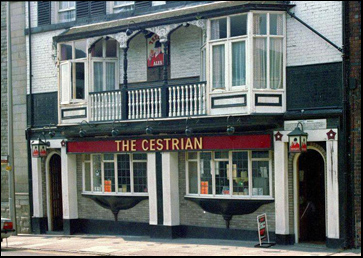 City Road: The Memphis (nos. 51 & 53) Licencee in 1942, Mrs G Edge. More info required here.. City Road: The Memphis (nos. 51 & 53) Licencee in 1942, Mrs G Edge. More info required here..
The Cestrian Hotel (no. 21, over the road from the now-demolished Royalty Theatre). Licencee in 1880 Benjamin Carter, in 1902 Thomas Wooliscroft, in 1914 Francis Massey, in 1919-20 O Ormerod.
In 2015, Ian Smith wrote on Facebook, "my family ran the Cestrian (the 'hotel' part of the name seems to have vanished by this time) - in City Road from 1964 till the mid 80s. The brewery was Ansells Ind Coope serving Double Diamond and Wrexham Lager. We had a cellar bar in which my dad built a bar using Gordon gin bottles. Very happy times".
The place continues as a hostelry today, albeit rather a trendier one, under the name of The Cellar Bar.
The Four-in-Hand (no.12, near the Royalty Theatre- now a garage forecourt). Licencee in 1919-20 Martha Barnes, in 1934-42 John D Gray. We'd like to know more about this place too!
The Grosvenor Park Hotel, (actually no.168 Foregate Street, corner of City Road). Landlord from 1902 to at least 1914 John Hayes, 1919-20 Mrs J Hayes. Affectionately known later as Dick Scott's after landlord E J H Scott who was here in 1934-42. The pub is illustrated here, decked out for King George VI's Coronation Day in 1937.
The licencee 1957-1963 was William A. Wikeley. His daughter Geraldine, now in Canada, sent us some memories of the place which you can read (and see another photograph) in our gallery. See also Jacqueline Naylor's reminisciences below...
A Chester map of 1871 shows that the place was called The Newpark Hotel at that time.
 Reader John Cooper recalled the area, "The Grosvenor Park Hotel was situated on the corner of Foregate Street and Earl's Villas (City
Road) opposite what was Slade's Garage. My Dad used to take me there on
Sunday lunchtime to see my Grandad, I guess I was about five at the
time, but I do remember itquite clearly, it was a Greenall Whitley
house. Reader John Cooper recalled the area, "The Grosvenor Park Hotel was situated on the corner of Foregate Street and Earl's Villas (City
Road) opposite what was Slade's Garage. My Dad used to take me there on
Sunday lunchtime to see my Grandad, I guess I was about five at the
time, but I do remember itquite clearly, it was a Greenall Whitley
house.
Just a few doors away (directly opposite Slade's Garage) was The Ring O' Bells, a Threlfall's House and that was run by Cec Lucas before he took over The Bridgewater. Then there was The Queen's Head on the corner of Seller Street (opposite what was Bradley's outfitters)
that also was a Threlfall's house, although when I used to go there in
the early 1970s to gamble away my wages playing snooker on payday ;-)
It was a Whitbread house".
Jacqueline Naylor (nee Billington) wrote, "Have just found your website and to my joy I see a photograph of my Great Grandparent's hotel, the Grosvenor Park Hotel
in City Road. My great grandfather's name was Frederick Billington
(1852-1892). He died actually in the pub. His death certificate names
it as the 'Park Hotel' which may have been a colloquial name regularly
used.
His widow, Hannah also died at the Grosvenor Park Hotel (proper
name) in Dec. 1899. Her death left two orphaned children, my
grandfather John Arrowsmith Billington (1885-1965) and his sister
Gertrude Annie. She was born in 1888- but I do not know what happened
to her other than she married an Isaac Roberts in 1913 and had a
daughter (1913) and a son (c. 1916). Isaac died in 1917 and is interred
in my Great Grandparent's grave in Overleigh Cemetery, Handbridge.
When Frederick and Hannah married they set up business together at the Iron Bridge Hotel in Egerton Street.
This had been the business of William Scott Holmes, first husband of
Hannah (he died 2 years after their marriage). My Grandfather, John
Arrowsmith Billington was born at the Iron Bridge Hotel. At some point
(yet to be established) they sold that and moved on the Grosvenor Park
Hotel.
Also on your website I see you have the name of Absalom Hayes as landlord of a pub at 132 Northgate Street. (the Grosvenor Arms- now Sayer's Bakery next to the Northgate).
Absalom was the brother of Hannah. He died in 1924 and is interred in
St Matthews Churchyard, Buckley in Flintshire (home town).
Interestingly Absalom and his brother John Hayes (died 1915 and
interred in Overleigh Cemetery also) are named as trustees of Hannah's
money to benefit her orphaned children. They were also given the
opportunity to purchase the Grosvenor Park Hotel for a reasonable sum
and to hold the money in trust for said children (then aged 13 & 11
years). Neither of the children benefited from their mother's estate
other than to finish their private education. Grandfather was educated
in Mold, Flintshire. Is this a case of the 'wicked uncles' spending
their charges inheritance? A belief widely held by my father's siblings
and still referred to by the few remaining children of John Arrowsmith
Billington." Fascinating stuff.
Champer's. The Chester artist Jill Pears told us, "I remember Champer's on City Road where you didn't have to be self-conscious as there were mirrors all round the dance floor! I spent my 18th birthday there in 1974 and saw Tom O'Connor there in 1976. I thought I looked very trendy in my canary-yellow halter neck dress and platform shoes!"
Slater's Directory lists a pub called The New Park in City Road in 1880 when its licencee was William A Billington.
In Spring 2012, The Cheshire Hangman, (4-8 City Road, furthest end from the station) closed its doors after staggering on as a joke of a place for far too long. It had formerly been Jones' Bar and was much better then.
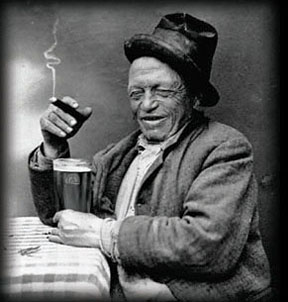 Cow Lane: See Frodsham Street Cow Lane: See Frodsham Street
"We old folks have to find our cushions and pillows in our tankards. Strong beer is the milk of the old." Martin Luther
Crane
Street
/ New Crane Street / Crane Bank: ('The Old
Port'): During the 19th century and early part of the 20th, there were numerous
inns and taverns around the Crane Wharf area supplying the needs of those working at the port and the sailors who visited it. Nearest to the dock was The Flint & Bagillt Boathouse, also known as The Flint Boathouse Inn. First recorded in Pigot's Directory in 1818 when Mr Richard Weigh was the licencee and the location is given as 'New Crane'. He was still there in 1822 when John Jones took over. Hid directory entry shows the inn as The Flint and Bagilt Packet House. In 1840 (in New Crane Street) the licencee was Maurice Lloyd and in 1850
Thomas Bethall. It appears as merely The Boathouse in the 1859 Post Office Directory of Cheshire, its licencee C Jones. Kelly's Directory for 1910 lists it again as The Flint Boathouse Inn, licencee W E Peel, who appears again in the 1919-20 directory.
The pub was owned by the Kelsterton Brewery Company of Flintshire, before being bought by the
old Northgate Brewery in 1903. It finally closed on February 18th 1923.
The 1902 edition of Kelly's Directory lists The King's Arms Tavern as trading at 40 Crane Street when the landlord was Robert Buckler. The 1910 edition shows the licencee as being Mrs R E Dew and that for 1919-20 Mrs Leatherbarrow. Earlier, in 1880, it had been Thomas Prescott, in 1857 J Wright, in 1840 William Jervis, in 1850 Peter Jones, in 1828 Benjamin Jones (Pigot's Directory) and in 1818-20 John Bellis (ditto). The latter was listed as being located in "Middle Crane-street".
The Amelia Tavern, 53 Crane Street, appears in the 1859 Post Office Directory of Cheshire, licencee H Trelford.
The Carnarvon
Tavern (no.1 Crane Bank). Landlord in 1822-28 Charles Griffith, in 1840 (when it was called The Carnarvon Castle Tavern) Charles Jones, in 1850-55 John Jones, in 1859 J Hallewell, in 1871 William Jones, in 1880 Samuel Jones, in 1902 Alfred Tennyson, in 1910-14 Mrs E Tennyson, in 1919-20 P E Tindle. The pub was mentioned, "located between the two Cranes Streets", in connection with a police murder investigation in the Cheshire Observer in April 1871.
The Jolly Tar- recorded as being used as a polling station in 1809. Pigot's Directory 1818-20 records The Royal Tar trading in "Middle Crane-street". The same place? (for the benefit of our overseas readers, a 'tar' was a Royal Navy sailor- a "Jolly Jack Tar").
The Crane Punch House. This inn was listed in Cowdroy's Directory in 1789 when the licencee was Thomas Hubbert. It was used as a polling station in 1809. By 1818, when the licencee was John Jones, it was listed in Pigot's Directory as The Punch Bowl. When Mary Rowland had it, ten years later in 1828, its name was changed to The Crane Tavern. Its proprietor in 1840 was Edward Williams, in 1855-80 Joseph Blackburn. The inn does not appear in the 1871 directory.
A conveyance (DJWW/359) of 1st Novemebr 1860 between Thomas Latham of Liverpool, hotel keeper and Edward Bate of Kelsterton, co. Flint, brewer, dealt with a "piece of land in the City of Chester used as a public house and known as The White House or Crane Tavern, formerly The Old Crane or Punch Bowl Inn".
The Weigh - also appeared in the 1809 polling station list.
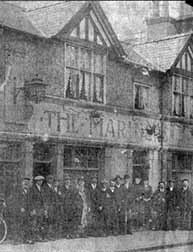 The
Ship Tavern (no 52). This inn was listed in Cowdroy's Directory in 1789 when the licencee was Mrs Cload. Licencee in 1818 John Hewitt, in 1822-3 G Joinson, in 1828 Mary Davies, in 1840 John Davies, in 1880 Thomas Samuel Jones. William Cowap is also listed as licencee that year (he was certiainly there in 1871). In 1902 it was William Allen, in 1914 W E Peel. The
Ship Tavern (no 52). This inn was listed in Cowdroy's Directory in 1789 when the licencee was Mrs Cload. Licencee in 1818 John Hewitt, in 1822-3 G Joinson, in 1828 Mary Davies, in 1840 John Davies, in 1880 Thomas Samuel Jones. William Cowap is also listed as licencee that year (he was certiainly there in 1871). In 1902 it was William Allen, in 1914 W E Peel.
The
Mariners' Arms (illustrated left). Nos 19 & 21, immediately next to the railway viaduct. Licencee in 1840-50 (when it was called The Mariners' Tavern) was Robert Kelly, in 1855 William Manley (it was called The Mariners' Arms by this time), in 1857 J Robinson, in 1871 James Whitlow, in 1880 Grace Owen, in 1902-1910 G H German, in 1914 A D Hughes, in 1934-42 Joseph Donnachie. A better version of this photograph is in our gallery.
The Sloop.
The Victoria, 28 Crane Street, appears in The Post Office Directory of Cheshire in 1856 when its licencee was B Jones. The same source lists another Victoria, licencee G Wilson, in Upton. Is it still there?
The Railway Tavern in Crane Street was mentioned in the Chester Trades Directory in 1850 when the licencee was John Davies. Slater's Directory records him still there in 1855.
The Waggoners- sitated "at the Watergate".
The Clock Vaults- between Middle and New Crane Streets.
The Victoria Arms Beer House was recorded as trading in Crane Street in 1822-3, licencee Benjamin Jones.
The Royal Tar Beer House was in Crane Street in 1840, licencee Peter Jones.
The Turf Tavern was renamed The Watergate Inn and still thrives outside the Watergate today- the only remaining pub in the area. The Watergate Tavern was recorded as being used as a polling station in 1809. Is this the same pub? The Watergate Tavern may not be the same as the current Watergate Inn because the Watergate Tavern is listed in the 1828-1829 directory as being in Paradise Row, but this no longer exists- unless, of course, the road is gone but the pub at the end of that road is still there...
Also appearing in that 1809 polling station list
were two inns in Crane Street with the intriguing names of Mrs. Cloud's and Mrs. Roger's.
Crewe Street: The Bridgewater Arms (no. 16) was listed in Slater's Directory 1880 when the licencee was Mary Campbell. Earlier, the house was mentioned in the Cheshire Observer, October 1873 where it was stated that its former name was The Napier. In 1910 it was listed in Kelly's Directory as The Bridgewater Hotel, licencee Mrs M A Bass, who was still there in 1914. In 1934-5 the landlord was Edward Hargrove.
Crook Street / Crook's Lane: The Lamb. Listed in Pigot's Directory 1818-20 when the licencee was Morris Roberts, in 1822 M Worrall and in 1828-9 Peter Jones. It appears again in the 1850 directory when its landlord was Edward Piercy.
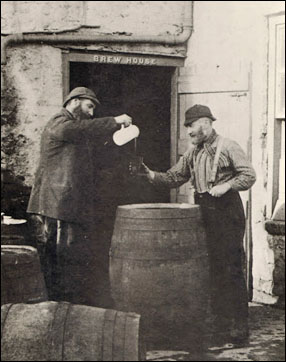 The White Lion Tavern is listed in Pigot's Directory for 1828/9 when the licencee was Peter Thomas, in 1840 James New. Other White Lions were in Foregate Street and the hotel in the Market Square. The White Lion Tavern is listed in Pigot's Directory for 1828/9 when the licencee was Peter Thomas, in 1840 James New. Other White Lions were in Foregate Street and the hotel in the Market Square.
Cuppin
Street: The Star Inn (no 34, now Hill Dickinson Solicitors). Its licencee in 1781 (in 'Cuppins Lane') was Mr Lawrenson (Mrs Lawrenson was recorded as a comb maker), in 1818 (listed as being in 'Cuppings Lane' in Pigot's Directory) William Evans, in 1822-3 William Owens, in 1828 Thomas Jackson, in 1840, when it was called The Star Tavern, Edward Jones, in 1855 Elizabeth Pritchard, in 1857 J Davies, in 1871-80 Peter Parker, in 1902 Mrs Emma E Edwards.
The Gas Tavern was run by John Ball for over a decade, yet there is no mention in the directories except in the 1893-1894 directory where it has has the following listing:
Gas Tavern, 38 Cuppin St. G.Edwards This suggests that it was a beer house that masqueraded as a tavern for most of the time. The Gas tavern existed for over 30 years so it's strange that it escaped the directories until 1893. The inn's name recalls that the first gas lighting to appear in Chester was in Cuppin Street:
"The Chester Gas Light Company was formed after a public meeting in 1817; the local banker G. B. Granville was elected chairman (serving as such until 1845) and the share capital of £6,850 was quickly taken up. The company hired the doyen of gas engineers, Samuel Clegg, to build the system, ensuring that its works in Cuppin Street, opened in 1819, was at the forefront of the emerging technology of gas supply. The immediate intention was to replace the inadequate oil lamps which the improvement commissioners provided for street lighting. The company won the contract to light the streets around its works in Cuppin Street in 1818, and at least the main city streets were gas-lit by 1830. The supply was inefficient and expensive, despite the relative cheapness of coal in Chester, but the company forestalled complaints by paying retainers to the lamp rate collectors and by having on its committee many members of the improvement commission. It also consciously subsidized the supply for street lighting in order to retain the commissioners' goodwill, but charged private customers enough to make large profits and pay handsome dividends in the period before 1838." (British History Online)
The Recruiting Serjeant - recorded (actually in Cuppin's Lane) as being used as a polling station in 1809 .
The Volunteer appears in 'Cuppings Lane' in Pigot's Directories for 1818-23, licencee Edward Davies. It was mentioned in the Cheshire Observer in late July and early August 1827 when it was being sold by auction.
The Manchester
Arms. There was another Manchester Arms in Princess Street.
The King's
Arms.
The
Standard.
The Fox & Barrel- junction of Grosvenor Street. Now a Brazilian restaurant. Previous eateries here were Ego and What's Cooking. The licencee in 1840 was James Callowhill.
Reader Patrick Deedy recently wrote to us: "I live at no. 22,
Cuppin Street, an 18th c town house on 3 floors. It is one of a pair
with no. 20, and the inner wall between us shows traces of a wide
archway, suggesting the houses were knocked together at some time. This
would have made one large building. You mention that Cuppin Street
contained several old pubs at one time. Is it possible that nos 20-22
formed one of those pubs- and when?"
Kelly's Directory for 1902 lists a Belgrave Vaults trading at 2 Cuppin Street and 14 Grosvenor Street when J Brown was the licencee.
Much more about the old pubs of this area under Grosvenor Street....
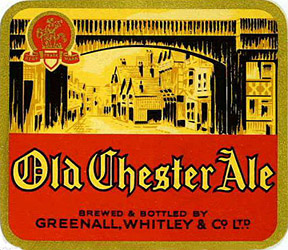 Drink! Drink! Drink! Drink! Drink! Drink!
To eyes that are bright as stars when they're shining on me!
Drink! Drink! Drink!
To lips that are red and sweet as the fruit on the tree!
Here's a hope that those bright eyes will shine
Lovingly, longingly soon into mine!
May those lips that are red and sweet,
Tonight with joy my own lips meet!
Drink! Drink!
Let the toast start!
May young hearts never part!
Drink! Drink! Drink!
Let every true lover salute his sweetheart!
From the Broadway Operetta 'The Student Prince' (1924) |
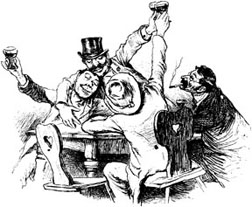

 The Glynne Arms (no.100, corner of Francis Street, illustrated right in February 2010). Landlord in 1857 E Pilsworth, in 1880 George West, in 1902 John Clarke, in 1910 Frederick William Attewell, in 1914 James Lowe, in 1919-20 J Anslow, in 1934-6 Harold Kelsey, in 1942 Harold E Miller.
The Glynne Arms (no.100, corner of Francis Street, illustrated right in February 2010). Landlord in 1857 E Pilsworth, in 1880 George West, in 1902 John Clarke, in 1910 Frederick William Attewell, in 1914 James Lowe, in 1919-20 J Anslow, in 1934-6 Harold Kelsey, in 1942 Harold E Miller.  If anyone can come
up with a picture of the old Glynne, contact Dave
If anyone can come
up with a picture of the old Glynne, contact Dave  In 1914 the licencee was Mr G Taylor, in 1919-20 A F Griffiths, in 1934-42 Frank Joseph Calderbank. Tony Vye was a licencee during the 1960s.
In 1914 the licencee was Mr G Taylor, in 1919-20 A F Griffiths, in 1934-42 Frank Joseph Calderbank. Tony Vye was a licencee during the 1960s. Thanks for the quip about the neighbours' complaints. That was a while back and we hear nothing from them anymore (fingers crossed). In fact, some of the residents are now members of the club and play bowls too! Cheers, John!"
Thanks for the quip about the neighbours' complaints. That was a while back and we hear nothing from them anymore (fingers crossed). In fact, some of the residents are now members of the club and play bowls too! Cheers, John!" Much earlier, in the opening pages of his Stranger's Guide to Chester (1856) Thomas Hughes, adressing visitors arriving via the new-fangled railway, wrote of the Liver, "those
carpet bags and cloaks, by the way, are but superfluous companions for
a jaunt around the city. Suppose then, that we drop in at the Liver, a
most respectable hotel within hail of the station, and there depositing
our baggage in one of the cosy bedrooms of that establishment, we will
sally forth upon our mission. After one night's sojourn at this house
you'll know your hotel, we promise you, for all future time".
Much earlier, in the opening pages of his Stranger's Guide to Chester (1856) Thomas Hughes, adressing visitors arriving via the new-fangled railway, wrote of the Liver, "those
carpet bags and cloaks, by the way, are but superfluous companions for
a jaunt around the city. Suppose then, that we drop in at the Liver, a
most respectable hotel within hail of the station, and there depositing
our baggage in one of the cosy bedrooms of that establishment, we will
sally forth upon our mission. After one night's sojourn at this house
you'll know your hotel, we promise you, for all future time".
 The Liverpool Arms. Listed in the History, Gazetteer & Directory of Cheshire, 1850 when the licencee was Robert Drury, in Slater's Directory 1855 licencee Lydia Drury and the Post Office Directory of Cheshire in 1857, when it was called The Liverpool Arms Commercial Inn, licencee Thomas Hobday Jnr. In 1871 Sarah Handley had the place. There was a Liverpool Tavern trading in Tower Street and The Liverpool Arms ('The LA'), but bearer of many previous names, continues to thrive close to the
The Liverpool Arms. Listed in the History, Gazetteer & Directory of Cheshire, 1850 when the licencee was Robert Drury, in Slater's Directory 1855 licencee Lydia Drury and the Post Office Directory of Cheshire in 1857, when it was called The Liverpool Arms Commercial Inn, licencee Thomas Hobday Jnr. In 1871 Sarah Handley had the place. There was a Liverpool Tavern trading in Tower Street and The Liverpool Arms ('The LA'), but bearer of many previous names, continues to thrive close to the 
 He travelled to Christleton, not only to sample the local brew, and have a small wager on horses, racing at Farndon, or perhaps gambling with his friends at the Glass House Inn, but also to visit his friend Mr Townsend at The Old Hall, often accompanied by his beautiful wife Suzanna. They would sometimes continue their journey on horse back through to Wareton, (Waverton) to see their son Jack who was the Curate there. He didn’t have a very good reputation, as he was often absent when needed, and seems to have been dismissed from his post because of these bad habits.
He travelled to Christleton, not only to sample the local brew, and have a small wager on horses, racing at Farndon, or perhaps gambling with his friends at the Glass House Inn, but also to visit his friend Mr Townsend at The Old Hall, often accompanied by his beautiful wife Suzanna. They would sometimes continue their journey on horse back through to Wareton, (Waverton) to see their son Jack who was the Curate there. He didn’t have a very good reputation, as he was often absent when needed, and seems to have been dismissed from his post because of these bad habits. 
 Reader John Cooper recalled the area, "The Grosvenor Park Hotel was situated on the corner of Foregate Street and Earl's Villas (City
Road) opposite what was Slade's Garage. My Dad used to take me there on
Sunday lunchtime to see my Grandad, I guess I was about five at the
time, but I do remember itquite clearly, it was a Greenall Whitley
house.
Reader John Cooper recalled the area, "The Grosvenor Park Hotel was situated on the corner of Foregate Street and Earl's Villas (City
Road) opposite what was Slade's Garage. My Dad used to take me there on
Sunday lunchtime to see my Grandad, I guess I was about five at the
time, but I do remember itquite clearly, it was a Greenall Whitley
house.  Cow Lane:
Cow Lane:

 Drink! Drink! Drink!
Drink! Drink! Drink!